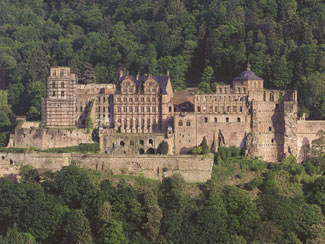| |
|



View
larger size |
 Castle Castle
Over the course of centuries, the Castle and its grounds reflected
the rise and fall of Heidelberg as a Prince Elector’s
residence. In the early 19th century, it made Heidelberg a
mecca of German romanticism. The Castle, the town and the
surrounding landscape blended with university and student
life to create the “Heidelberg legend”, while providing
exciting new inspiration to composers, painters and poets.
A fort (castrum) in Heidelberg was first mentioned in 1225
in a document in which Duke Ludwig of Bavaria granted a fiefdom.
The existence of two different forts since 1303 has been confirmed.
The upper one was located where the Molkenkur is today, but
was struck by lightning and burned down in 1537. Only a few
remnants of its walls are left. Both were elevated forts typical
of those built by the Staufers in southern Germany. |
The lower fort, which later became the Castle, was built in
two main phases. The first, in the late Middle Ages between
about 1400 and 1544, saw the construction of fortifications
and living quarters. During the second, attractive palace
buildings in Renaissance style and the magnificent Castle
Gardens (Hortus Palatinus) were gradually added up until Heidelberg’s
sacking and destruction in 1689 and 1693.
The single most important individual who contributed to the
Castle was Ludwig V. He extended and strengthened the fort
to withstand attacks by soldiers with firearms, the use of
which was spreading at that time. The only parts that are
even older are the Ruprechtsbau (erected around 1400) and
portions of the eastern ramparts. The later construction periods
were typified by constant changes and additions to individual
structures by successive Prince Electors, although they always
made sure to preserve the overall complex. As a result, today
the Castle boasts a rich diversity of different styles, which
enhances further the picturesque, romantic aura of the ruins.
Chronicle
1400-1544
The medieval fort grows into a castle complex.
1549-1620
During the second main phase, the transition from Gothic to
Renaissance styles is quite evident.
1549
Completion of the glazed hall.
1556-59
Construction of the Ottheinrichbau, probably the most beautiful
Renaissance palace north of the Alps.
1601-07
Construction of the Friedrichsbau.
1612-19
The famous Castle Gardens and the English Building are built
under Prince Elector Friedrich V.
1688/89
French troops occupy Heidelberg during the Palatinian War
of Succession. Parts of the town are destroyed.
1693
The French occupy Heidelberg again and destroy much of the
town. The Castle fortifications are blasted apart.
After 1742
Reconstruction of the palace building under Prince Elector
Karl Theodor. The Big Barrel, with a capacity of 221,726 liters,
replaces an older one that held about 195,000 liters.
1764
Lightning destroys large parts of the Castle. Work on it is
halted.
1810
The French emigrant Charles Graf von Graimberg undertakes
to preserve the Castle ruin as his life’s work. He starts
by putting together a collection of found items from the Castle.
Around 1900
Restoration and extension of the Castle to preserve its architectural
history. |


|
|
|